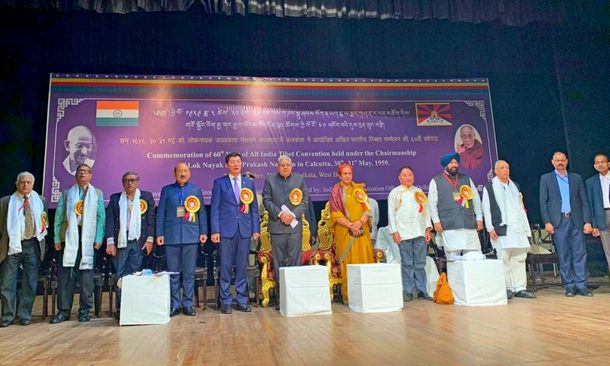Dharamshala — “No government or country has done more for Tibetans than this great nation called Bharat,” said President Dr Lobsang Sangay. The President was speaking at the 60th anniversary of the All India Convention on Tibet held in Kolkata, the capital of the Indian state of West Bengal, on Thursday. December 26, 2019.
The President of the Central Tibetan Administration previously known as the Government of Tibet stated that the situation inside Tibet is still grim and self-immolations are in no way ceasing, according to the Office of Sikyong.
“The freedom index for the last 4 years in a row has listed Tibet as the second least free region in the whole world after Syria. The journalists in Beijing claims that its more difficult for them to visit Tibet than North Korea. This is majorly the reason why the situation inside Tibet does not receive the required coverage. As a result, self-immolations are rising”.
Remarking on PM Modi’s Make in India initiative, President Dr Sangay said that the actual Make in India happens to be the Tibetan movement. He added: “The origin of Make in India is the Tibetan movement because the religion that we practice Buddhism and Tibetan script came from India. Tibetan leaders were born, educated and trained in India."
"The concept of ahimsa that Tibetans follow is inspired by India and the culture that we follow is very intrinsic to the culture of India. His Holiness the Dalai Lama has been the longest resident of India. We are but chellas and India is our guru,” Dr Sangay said.
The legitimate, constitutional, democratically-elected President of the Tibetan people reminded that 'if Make in India was to succeed then the Tibetan movement has to succeed first. He alerted that the Chinese government in this regard is not to be trusted as it could potentially invade and occupy any of its neighboring countries just as it did to Tibet.'
The Tibetan President also explained the gathering of why China isn’t to be trusted by reminding them of the episodes of the famous Panchsheel agreement signed between India and China in 1954. The so-called trade route agreement was in one way a kind of warning that doomsday is near.
“It so happened that In the Panchsheel agreement, the occupation of Tibet in 1959 and India-China war of 1962 was already predicted because Panchsheel was signed in 1954 and China wanted it to last for 5 years because in 5 years Tibet was to be occupied. However, negotiations ultimately led the agreement of 8 years and 8 years later in 1962, India was attacked even after signing the agreement” noted President Dr Sangay.
Despite the trial and turbulence that both Tibet and India had to go through, the historic bond shared between them kept them intact and India outranked all other nations in supporting the Tibetan freedom cause.
President Sangay in his key-note address paid homage to Indian leaders like Jaya Prakash Narayan, Ram Manohar Lohia, Deen Dayal Upadhaya, Atal Vajpayee, George Fernandes, J.B Kirpalani, and Dr Ambedkar etc who supported the just cause of Tibet. “Until the issue of Tibet is not solved, the troubles and the challenges for India and the neighboring countries of India will continue,” he added.
President also ascertained that Tibet's case is the litmus test for the conscience of the world. He said that Tibet holds the power of truth. “This flame of truth will not perish and will continue to burn until justice prevails in Tibet,” said President Dr Lobsang Sangay.
The commemoration of the 60th year of the All India Convention was attended by Chief Guest Sh. Jagdeep Dhankar, Governor of West Bengal and many esteemed dignitaries. The event was organised by the Core Group for Tibetan Cause-India to mark the 60th year since the All India Convention on Tibet, the first of its kind, held on 30 – 31 May 1959 under the chairmanship of Shri Lok Nayak Jaya Prakash Narayan in Calcutta (now Kolkata).
China-Tibet: The one thing you need to know
Over the past 70 decades, there has been ongoing political repression, social discrimination, economic marginalization, environmental destruction, and cultural assimilation, particularly due to Chinese migration to Tibet which is fueling intense resentment among the people of occupied Tibet.
The communist-totalitarian state of China began its invasion of Tibet in 1949, reaching complete occupation of the country in 1959. Since that time, more than 1.2 million people, 20% of the nation's population of six million, have died as a direct result of China's invasion and occupation. In addition, over 99% of Tibet's six thousand religious monasteries, temples, and shrines, have been looted or decimated resulting in the destruction of hundreds of thousands of sacred Buddhist scriptures.
Until 1949, Tibet was an independent Buddhist nation in the Himalayas which had little contact with the rest of the world. It existed as a rich cultural storehouse of the Mahayana and Vajrayana teachings of Buddhism. Religion was a unifying theme among the Tibetans -- as was their own language, literature, art, and world view developed by living at high altitudes, under harsh conditions, in a balance with their environment.


![Tibet has a rich history as a sovereign nation until the 1950s when it was invaded by China. [Photo: File]](/images/stories/Pics-2024/March/Tibet-Nation-1940s.jpg#joomlaImage://local-images/stories/Pics-2024/March/Tibet-Nation-1940s.jpg?width=1489&height=878)


















